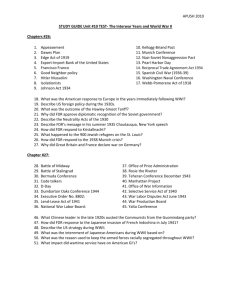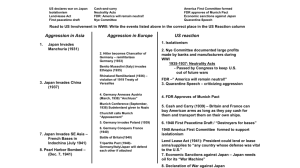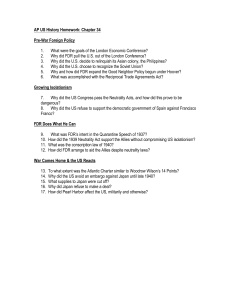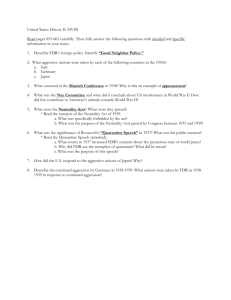The United States During the Interwar Years (1920
advertisement
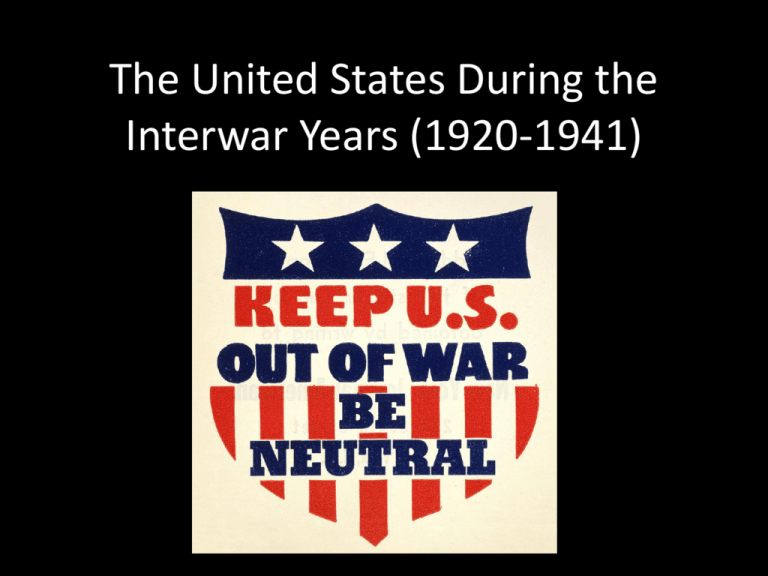
The United States During the Interwar Years (1920-1941) Interwar Years Foreign Policy While portrayed by history as a period of isolationism, the U.S. actually engaged in independent internationalism. • U.S. acted unilaterally to maintain independence. • The U.S. was internationally involved in protecting its diplomatic and economic interests. *Wilsonian idealism continued to influence foreign policy: Washington Conference (1921-22) Produced 3 treaties which Five-Power Treaty: put limits on naval forces – esp. battleships Nine-Power Treaty: guaranteed the Open Door in China Four-Power Treaty: respect for Pacific possessions Locarno Pact (1925) Reduced tensions between France & Germany Kellogg-Briand Pact (1928) International effort to outlaw war U.S. Interwar Policies Toward Latin America • Hoover ended the interventionist policies of the Progressive presidents and withdrew American troops from Nicaragua and Haiti. FDR’s Good Neighbor Policy Dollar Diplomacy was no longer economically feasible Militaristic regimes in Europe motivated FDR to improve US relations with hemispheric neighbors Pan American Conferences: At a succession of conferences the US pledged not to intervene in LA; FDR attended in 1936 and pledged to resolve disputes through arbitration and defend the hemisphere from foreign aggression. Cuba: U.S. nullified the Platt Amendment and only retained Guantanamo Bay. Mexico: Never good relations were strained by the 1938 move to nationalize the oil industry. U.S. oil companies lost millions and demanded intervention to protect American interests/property. FDR’s Economic Diplomacy • Recognition of the USSR • Philippines – FDR supported the Tydings-McDuffe Act (1934), which provided for Filipino independence in 1946. • Reciprocal Trade Agreements – 1934 initiative to spur international trade, president granted power to reduce US tariffs up to 50% for nations that reciprocated with comparable reductions for US imports. Rise of Militaristic Regimes: Italy Fascist Benito Mussolini takes power in 1922. Appealed to dissatisfied veterans, nationalists and others afraid of rising communist tide. Sought to unite Italians behind foreign aggression. Japan Nationalists & Militarists increase their power during the 1920s & 1930s. Economic depression motivates Japan to move aggressively to ensure its supply of natural resources – declare the Greater East Asia Co-Prosperity Sphere. In 1931, Japan invades Manchuria. Germany The National Socialist Workers Party (Nazis) emerge from the chaos of 1920s German Politics, with a charismatic leader, Adolf Hitler. In 1933, the Nazis form a coalition government and Hitler becomes chancellor. American Isolation American disillusionment after WWI still fresh. Japanese, Italian, and later German aggression confirms to many Americans that the US should not be drawn into another foreign conflict. Nye Committee Report – Congressional investigation, which reported in 1934 that the US had been economically motivated to enter WWI. (To protect US investments/loans & arms manufacture) Neutrality Acts - Congress forced FDR to sign a series of Neutrality Acts designed to prevent the US from engaging in diplomacy or trade that would put Americans in harm’s way or be perceived by a hostile country as an act of war. America First Committee - By 1940, a growing number of Americans were concerned by FDR’s pro-British policies. High profile Americans, like Charles Lindbergh, toured the country making speeches warning of US involvement in European troubles. Militarism on the March 1935 1936 1936 1936 1937 1938 Italy invades Ethiopia Germany marches into the Rhineland Rome-Berlin Axis formed Spanish Civil War begins Full scale war between Japan & China Germany “appeased” by Britain & France and allowed to take Sudetenland 1939 Nazi-Soviet Pact 1939 Germany invades Poland 1940 Japan joins Tripartite Pact with Germany & Italy U.S. Response: 1940 Selective Service & Training Act passed and instituted the first peace-time draft. 1941 Lend-Lease Act allows Britain to borrow money and barter for leases on territory. (Previously been Cash & Carry)
